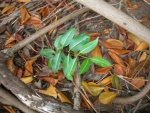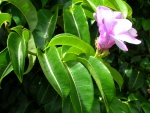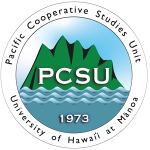aka Rubber Vine (Cryptostegia grandiflora) and (C. madagascariensis)
Family: Asclepidaceae
The Division of Forestry and Wildlife of the Hawaii Department of Land and Natural Resources has designated this species as one of Hawaii’s Most Invasive Horticultural Plants.
Description:
- Fast growing, climbing plant usually with pinkish-purple flowers (sometimes white to pink or light purple). Can also grow as a bush.
- Shiny, dark green leaves that are about 7 cm (3 in) long, with triangular, 10 cm long (4 in) seedpods that grow in wing-like pairs.
- Native to Madagascar, introduced to Hawaii as drought-resistant ornamentals.
Harm:
- Grows over other plants and trees to 13 m (45 ft) high, smothering and killing other vegetation.
- Twines tightly around other plants and restricts their growth.
- Extremely poisonous: it contains cardiac glycosides, which interfere with heart operation in humans and animals when the plant is eaten.
- When the vine is dry, a powdery dust emerges and can cause violent coughing, swelling of the nose, and blistering of the eyelids.
- Contact with the plant’s milky sap can cause burning rashes and blisters.
- Each seedpod contains 340-840 seeds, silky hairs on seeds allow them to spread by wind and water, seeds are also known to float and survive for a month in salt water before being washed ashore to sprout.
- Introduced to Western Australia, now considered one of the 10 worst invasive plants.
In Hawaii:
- Kauai – Present in limited numbers in ornamental settings, but not a KISC target at this time. Property owners are encouraged to remove this plant from their land (carefully).
- Oahu – Present in landscaped areas including Diamond Head, Hawaii Kai and Bishop Museum; infestations also occur. OISC is currently determining the feasibility of controlling rubbervine. All population sightings should be reported to OISC for mapping and assessment.
- Maui – There are a few sites on Maui that are being controlled by MISC. Unfortunately, rubbervine is widely available to the public through internet seed companies, few of which describe the plant’s invasive qualities.
- Molokai – One large infestation is known, from a couple of original plants distributed by a home gardener in East Molokai. MoMISC is unable to control this infestation with current resources. Landowners are encouraged to control this plant and to call MoMISC for control advice.
- Lanai – Presence/absence unknown
- Kahoolawe – None known
For more information, see:
- Cryptostegia grandiflora information from HEAR
- Cryptostegia grandiflora information from PIER
- Cryptostegia grandiflora information from ISSG
- Cryptostegia madagascariensis information from HEAR
- Cryptostegia madagascariensis information from PIER



